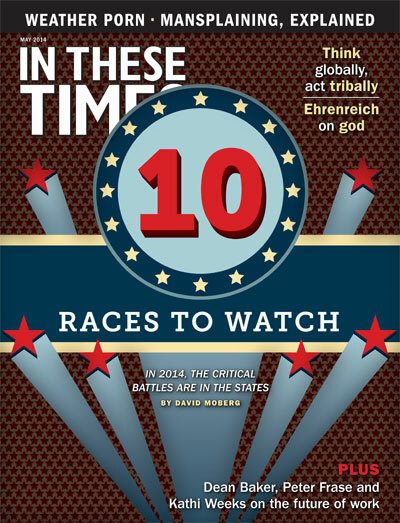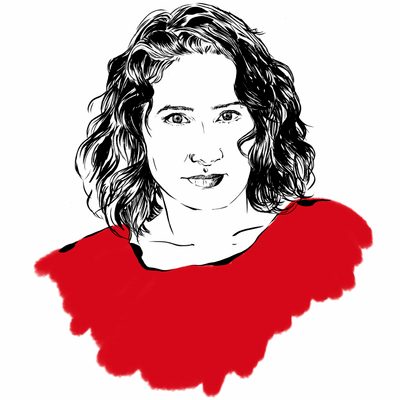Barbara Ehrenreich on Science vs. Mysticism
In Ehrenreich’s new book, she comes out about mystical experiences in her teens. Then she puts them under a microscope.
Sarah Jaffe

Barbara Ehrenreich is not the writer you would expect to publish a memoir about “mystical experiences” in her youth. One of America’s sharpest social critics, Ehrenreich has been exposing the ugly truths behind the country’s most persistent myths for decades. As one of In These Times’ founding ‘sponsors,’ she was a regular contributor to the magazine in its early years.
Most recently, she punctured our bubble of positivity in Bright-Sided: How the Relentless Promotion of Positive Thinking Has Undermined America. She may be best known for the time she spent as a low-wage worker for Nickel and Dimed: On (Not) Getting By in America, an investigation into the challenging low-wage jobs available to supposedly unskilled women.
But in her new book, Living With a Wild God: A Nonbeliever’s Search for the Truth About Everything, Ehrenreich takes us through her teenage years via a journal that she withheld from the Harvard archive that contains her papers. As a youth, Ehrenreich was an atheist — spirituality “being a crime against reason” — with an aptitude for science encouraged by her coal-miner-turned-Gillette Corp.-executive father.
However, throughout her teens she had uncanny dissociative experiences that culminated, on the drive back from a ski trip to Mammoth Mountain, Calif., in May 1959, in “an event so strange, so cataclysmic, that I never in all the intervening years wrote or spoke about it.” She describes this experience as a “furious encounter with a living substance that was coming at me through all things at once.” It left her profoundly shaken.
As a graduate student in cellular biology at Rockefeller University, Ehrenreich plunged into activism, but decades later finds herself still grappling with the otherworldly experience that confronted her 17-year-old self.
Emphatic that this very autobiographical book is not an autobiography, Ehrenreich weaves together philosophy and science, turning her sharp critic’s eye on her parents, herself and her experiences. The result is a page-turner that is stylistically unlike anything she’s written but, thematically, deeply connected to her prior work. She invites the reader to join her on a quest for truth, but refuses to draw easy conclusions. Ehrenreich talked with In These Times about her book and its themes of science, religion, atheism and authority.
You mention several times in the book that talking about your mystical experiences seemed to be a “punishable offense” — one that might get you locked up. Do you feel that you took a risk in writing this book?
Oh, yes. I am happy to report that among people I’ve talked to who have read the book so far, nobody has said I’m insane. I really was nervous, and it was an enormous leap for me to talk to anybody about it.
I remember a few years ago telling my son — Ben Ehrenreich, he’s a great writer — what I was working on. We were in this little shopping center Chinese restaurant and I said, “I have to tell you something.” Of course he looked nervous. I said, “It’s about something that happened to me when I was 17.” Then he looked really upset. I said, “I had, I think it’s called, a mystical experience.” And he just sighed in relief. I don’t know what he had imagined. But it was so hard for me to get those words out, even with somebody I’m that close to.
I think I kept coming back to it in part because I am such a rationalist. I want to understand. I can’t just push aside an aberrant bit of data, because that’s the little piece of data that may change everything.
I saw themes from other work of yours—Bright-Sided; Dancing in the Streets: A History of Collective Joy; Blood Rites: Origins and History of the Passions of War; and Witches, Midwives and Nurses: A History of Women Healers. Belief, rationality, power and ritual run through all of them.
Dancing in the Streets and Blood Rites certainly fed into this. Blood Rites introduced me to some things about religion.
I had always tended to think of religion in terms of the monotheistic religions that are so prominent today, and then I realized that before 2,000 or 2,500 years ago, most people weren’t monotheists, and their deities were as likely to be animals, or animal-like, as human in shape. And nobody thought these deities were good or moral. Even when you get to the completely human-shaped Greek gods, they’re just out of control. So the idea of a one perfect good god is a fairly recent one, and I think wrong.
Then I think Dancing in the Streets put me on the trail to the widespread occurrence of — I don’t like to say “altered states of consciousness” because it sounds so druggy — but ecstatic experiences that take people out of the mundane for at least a while. It was very important for me to realize that this was a widespread thing.
You write about your family’s atheism as connected to a working-class resistance to authority, as well as a refusal to take anything on faith.
The notion of a good god becomes a way of legitimizing human authority. The king has divine right and it comes from this good god, so how can you question anything?
You are critical of science as well as religion. You say several times that science often seems to be out to “crush any sign of autonomous life” rather than to discover it. How would you like to see this change?
First, let me say that there’s a good reason science is like that. Whatever phenomenon I’m studying in the laboratory, I can’t just say, “Oh well, these things happen because little creatures make them happen.” I’ve got to find out what they are, what makes them work. Science is reductionist in spirit.
But I think it went a little too far. The biggest, most obvious example was the denial for so long of the idea that nonhuman animals could have feelings or consciousness of any sort. That defies actual human experience with animals. But it’s just in the last few decades that that kind of scientific work has taken off.
I would like science to leave open the possibility of non-human intelligent consciousness. But you don’t just fall on your knees and worship it. That’s where I can’t stand spirituality; I can’t stand people who say, “Oh, it’s a lovely mystery.” No. We’ve got to find out what it is.
You write about the sexism you encountered in science, in dealing with the “macho” culture while the only woman in the lab, and even in tensions with your father. Do you think this is connected to the tendency we just spoke of?
That’s an interesting question. I’m not sure I could answer it. I have those same reductionist urges as a woman. But I think you could probably make an interesting case, and I’m thinking now of Evelyn Fox Keller’s critique of biochemistry.
You talk about having tried to dismiss the experiences you had as a teenager as mental illness, and then coming back and realizing that many people have had similar experiences. I’m wondering if you’ve read much of the writing lately on the need to repoliticize mental illness.
Definitely. That really begins as far as I know in the 1960s, the emergence of radical psychiatry, and ideas that schizophrenics for example might have greater insight, that we should listen to them. This is not something I’m very familiar with but I did read about it some, years and years ago.
I kind of make fun of psychiatry in the book, the quotes which are basically saying that mental illness is “not thinking like everybody else.” It’s any kind of cognitive or intellectual nonconformity. That’s really vicious and limiting.
I was very interested to learn recently about the neurodiversity movement, a movement of people saying, “Yes, we’ve been defined as mentally ill, but we’re just seeing things differently.” That’s cool, I’d like to know more about them.
How much do you still feel like the girl who wrote that journal?
It’s a funny relationship to have with your teenage self. I guess I feel a little maternal toward her. There’s no getting away from that, at my age. A novelist might try to say, “Well, because these things happened to me in my childhood, then I had these kinds of anomalous experiences and then this led to my life as an activist.” I’m not so sure. The reader is invited to connect those dots, but just can’t.
Sarah Jaffe is a writer and reporter living in New Orleans and on the road. She is the author of Work Won’t Love You Back: How Devotion To Our Jobs Keeps Us Exploited, Exhausted, and Alone; Necessary Trouble: Americans in Revolt, and her latest book is From the Ashes: Grief and Revolution in a World on Fire, all from Bold Type Books. Her journalism covers the politics of power, from the workplace to the streets, and her writing has been published in The Nation, The Washington Post, The Guardian, The New Republic, the New York Review of Books, and many other outlets. She is a columnist at The Progressive and In These Times. She also co-hosts the Belabored podcast, with Michelle Chen, covering today’s labor movement, and Heart Reacts, with Craig Gent, an advice podcast for the collapse of late capitalism. Sarah has been a waitress, a bicycle mechanic, and a social media consultant, cleaned up trash and scooped ice cream and explained Soviet communism to middle schoolers. Journalism pays better than some of these. You can follow her on Twitter @sarahljaffe.









